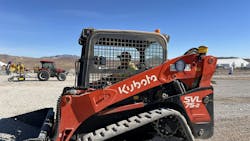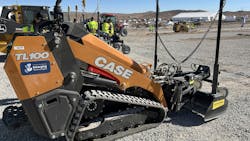Tech giant Trimble has been increasing its reach by tailoring machine control technology to smaller machines and site contractors with smaller fleets.
“[Our idea of small] is probably not doing huge infrastructure jobs,” said Steve DiBenedetto, Trimble Siteworks product manager. “They’re doing more of the commercial-type buildings, houses, subdivisions, strip malls, those sorts of things.
“A lot of times when we think of them from the Trimble side, it’s that they’ve not quite adopted the technology as much as they're still doing things, dare I say, the old-fashioned way without grade control technology,” DiBenedetto said. “They might not have survey technology and they’re just going out bidding and winning the jobs that they're most comfortable doing.”
DiBenedetto said one of the biggest barriers to adaptation has been time. That’s time off jobs there is no one else available to do, and perhaps a week to learn a system.
“Then the other side is that it’s not necessarily a cheap investment to get into, so sometimes there is a bit of sticker shock,” DiBenedetto said.
“We offer Siteworks machine guidance,” DiBenedetto said. “What’s cool about that is that it’s both an on- and off-machine system you’re able to use a traditional survey rover, GNSS rover, GPS, to do traditional surveying tasks, as-builting, measuring, staking, but then you’re also able to take that exact same system and add that to both an excavator and now a compact track loader—and you're using the same software and the same hardware.”
That means capitalizing on the initial investment by moving the technology from machine to machine and not needing multiple systems.
“You simply take your handheld data collector, handheld computer, move that from your survey rod to your excavator, and then move it onto your compact track loader, and just move your GPS unit between all of them as well,” Benedetto said.
“There are other offerings that we have that are machine focused. Earthworks Go! is another nice offering that is relatively affordable and that can get contractors or small site contractors into entry-level sort of grade control options, too.”
Trimble sets up much of its technology to grow as the user’s business grows.
How to control compact track loader costs
“Scalability is a key component to really all our solutions, and that scalability can come from buying an entry-level software and hardware system that itself can be upgraded so you can actually add more capabilities by adding modules,” DiBenedetto said.
“There are also options to add more technical capabilities. For example, you might start off with something like Site Works machine guidance, which gives you just guidance,” DiBenedetto said. “It’s not tied into the hydraulics of the machine. But when you realize that it has a lot of value, and that you’re ready to take it to the next level and you get more comfortable with, say, 3D designs, you're then able to get into a system like Trimble Earthworks that has full-on grade control.”
Full grade control is tied into a machine’s hydraulic system, and it automatically controls the blade elevation or a bucket to follow a design.
“That can come as your company is increasing, hopefully in size and the jobs and bids you’re able to land,” DiBenedetto said.
The company, and its Sitech dealers, can offer help to measure a system’s ROI.
“They have many, many calculators that can do that,” DiBenedetto said. “Sitech is going to come in and understand the type of work contractor does, their challenges, and their pain points. They can come up with almost a bespoke technological solution to help that contractor maximize ROI.”
DiBenedetto also said there are no shortage of case studies available that can help justify the technology and its time and cost savings.
“We’ve seen 20, 30, up to 40%; if you can work 20 to 30% faster and get a job done that used to take you five days in four days—after five jobs, you’ve got a whole other week that you could conceivably free up to spend on other bids and jobs,” he said.
For system acquisition and eventual scalability, Trimble offers a subscription model purchasing solutions for managers.
“You can buy the hardware and the software effectively on subscription,” DiBenedetto said. “So instead of making a huge initial capital outlay at the front and writing a check with a lot of zeros, you can sign up to write a monthly check with many, many fewer zeros. That comes with a lot of benefits, in that you’re always having the latest and greatest technology, with hardware and software and firmware available.
“Once you’re subscribed to Trimble through our Works and Works Plus offerings, you’re guaranteed to always be entitled to not only software upgrades, but also hardware upgrades,” DiBenedetto said. “You’re investing in that, and when Trimble comes out with the next generation sensor, the next generation GPS, the next generation handheld computer, you’re going to be getting that for no additional cost.”
Managers can ask their dealer for upgrades at any time. They will deliver it at no additional cost, DiBenedetto said. And there’s more.
“One of the other benefits about being on subscription is we include additional coverage for accidental damage,” he said. “Without it, if an instrument falls off the back of your truck and you run over it with a dozer, you're essentially out of luck unless you have third-party insurance. But if that's included in your subscription, you get a number of ‘oopsies’ included, and we'll just replace that hardware.”
About the Author
Frank Raczon
Raczon’s writing career spans nearly 25 years, including magazine publishing and public relations work with some of the industry’s major equipment manufacturers. He has won numerous awards in his career, including nods from the Construction Writers Association, the Association of Equipment Manufacturers, and BtoB magazine. He is responsible for the magazine's Buying Files.




